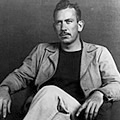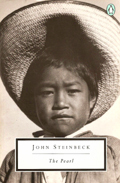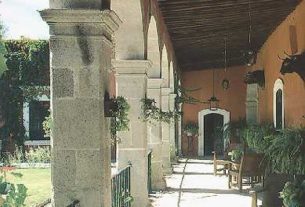Available from Amazon Books: Paperback
 That first film version of The Pearl (1948) was directed by the prominent Mexican director, Emilio Fernández. It won the Ariel – the Mexican Academy Award – for best picture, and Gabriel Figueroa won the Golden Globe for best cinematography; the director, Emilio Fernández, was nominated for a Golden Lion award at the Venice Film Festival.
That first film version of The Pearl (1948) was directed by the prominent Mexican director, Emilio Fernández. It won the Ariel – the Mexican Academy Award – for best picture, and Gabriel Figueroa won the Golden Globe for best cinematography; the director, Emilio Fernández, was nominated for a Golden Lion award at the Venice Film Festival.
What is a novella? The novella is a fictional narrative generally between 20,000 and 40,000 words; and it is usually centered around a single defining event. Although popular in Europe and Latin America, the novella is not a common form of literature in English. A few, though, are part of our literary canon, like Joseph Conrad’s The Heart of Darkness, George Orwell’s Animal Farm, and Hemingway’s The Old Man and the Sea. The novella is also a respected form in Latin America, represented by such classics as Gabriel García Márquez’s No One Writes to the Colonel, Juan Rulfo’s Pedro Páramo, and Julio Cortázar’s The Pursuer.
 Two of the best are by American author and Nobel Prize-winner, John Steinbeck: Of Mice and Men, and the classic novella set in Mexico, The Pearl.
Two of the best are by American author and Nobel Prize-winner, John Steinbeck: Of Mice and Men, and the classic novella set in Mexico, The Pearl.
The Grapes of Wrath (1940), Steinbeck’s long novel about “Okies” (Oklahoma farmers) trying to survive during the Dust Bowl of the 1930s, brought Steinbeck fame and fortune. But, after being attacked as a subversive for his suggestions that cooperation might be the way to address economic inequities in the United States, and living with his own new fame and fortune, Steinbeck began to question what fame and fortune were.
The Pearl (1945), then, is about a Mexican man named Kino and his wife Juana. They have a young son they dearly love, Coyotito. They are poor, illiterate, and initially innocent, innocent like those characters that often wander through Steinbeck’s novels. He wrote that this type of character, who possessed “kindness and generosity, openness, honesty, understanding and feeling,” was, by these very traits, ill equipped for the capitalistic society in which they found themselves.
This novella is a parable. Steinbeck was well acquainted with the Bible and the parable of the “pearl of great price,” which is a metaphor for Heaven. But the pearl in Steinbeck’s parable, a pearl “large as a sea-gull’s egg” and “perfect as the moon,” is the “pearl of the world,” decidedly not of Heaven. The sudden wealth that has fallen into his hands after the idealistic Kino finds the pearl (a story based on a legend Steinbeck had discovered during his explorations of the Sea of Cortez) also brings with it sudden calamity. (“The Pearl of the World,” incidentally, was Steinbeck’s original title for the novella.)
Kino is idealistic, and his high hope is that the pearl will allow him to educate his son Coyotito so that he can then return to be a savior of the village:
“My son will read and open the books, and my son will write and will know writing. And my son will make numbers, and these things will make us free because he will know – he will know and through him we will know.”
His down-to-earth peasant wife, Juana, is realistic. With common sense she cautions Kino about his ideals. She warns him about the greed of the villagers as well as about the change in his own character that has come about since he came to find “the great pearl” – a change that allows him to kill without remorse those who try to steal the pearl away. But for Kino to give up the pearl to those who wish to steal it or cheat him out of it is to give up his chance to lift his son out of generations of poverty.
His wife Juana soon realizes that the pearl is evil… “Throw the pearl back into the sea or it will destroy us.” But she also realizes that Kino is, after all, a man, and there was “no anger in her for Kino.”
“Juana, in her woman’s soul, knew that the mountain would stand while the man broke himself; that the sea would surge while the man drowned in it. And yet it was this thing that made him a man, half insane and half god, and Juana had need of a man; she could not live without a man.”
Ultimately the simple Kino recognizes that, in his obsession, the pearl has become his soul.
Seventeen of Steinbeck’s books were made into films, including East of Eden, Of Mice and Men, Cannery Row… and The Pearl. John Steinbeck had, at the suggestion of Emilio Fernández, originally written the story with a movie in mind. Steinbeck, Emilio Fernandez, and old Jack Warner worked together to create the screenplay.
That first film version of The Pearl (1948) was directed by the prominent Mexican director, Emilio Fernandez, whom Steinbeck had met in 1941 while vacationing in Mexico and to whom Steinbeck had first told the story of “the pearl.” It starred Pedro Armendáriz, one of the biggest names in Mexico cinema, who had just recently costarred with stunningly beautiful María Félix in the box-office hit, Enamorada. Nevertheless, the film received little attention in the United States. But in Mexico it won the Ariel – the Mexican Academy Award – for best picture, and Gabriel Figueroa won the Golden Globe for best cinematography; the director, Emilio Fernández, was nominated for a Golden Lion award at the Venice Film Festival.
In film or fiction, The Pearl is a good story. I like the novella form a lot, in part because I can sink down into a soft chair and read one beginning to end in a couple of hours. But I also like the narrative form of the novella, the entire story usually turning and turning around one single event. When it is as fine as The Pearl, those couple of hours go by too fast. It is one of those stories so simple that it becomes profound.

